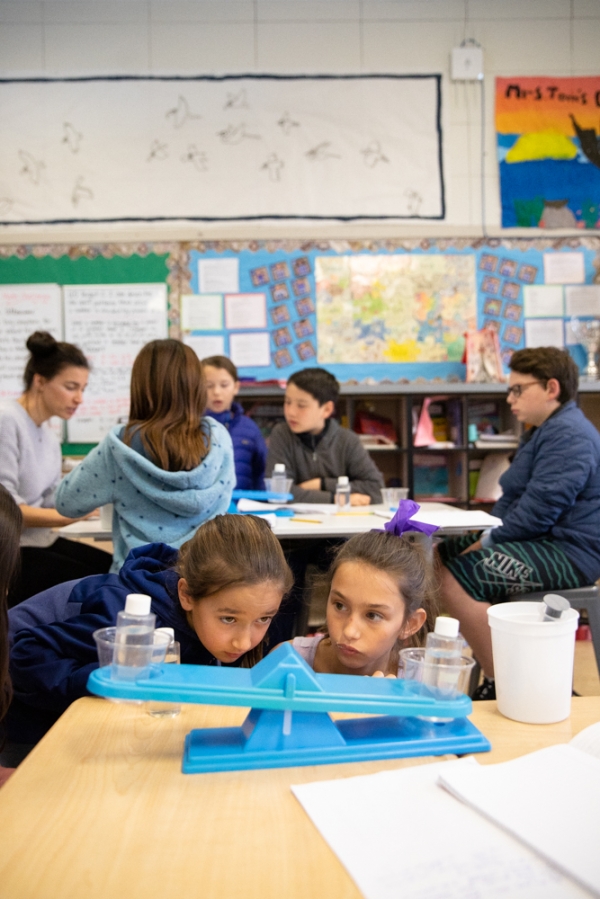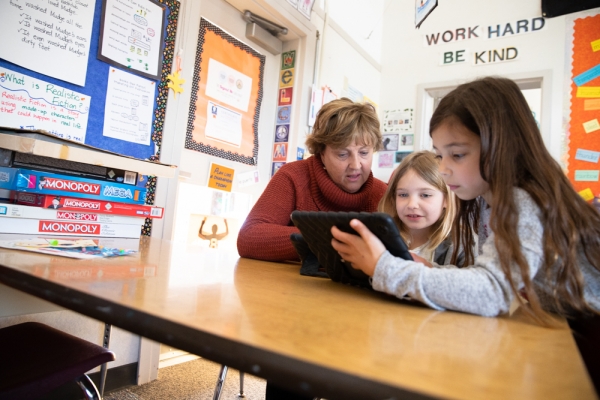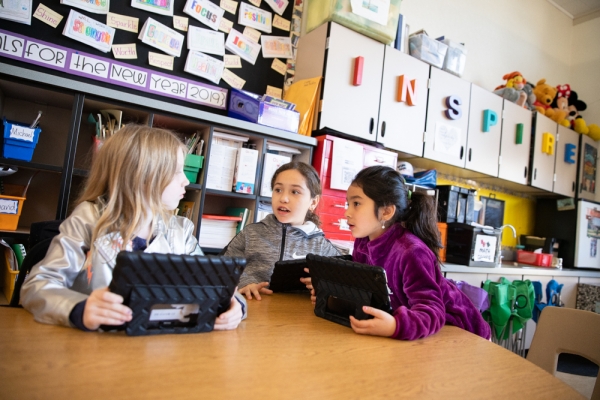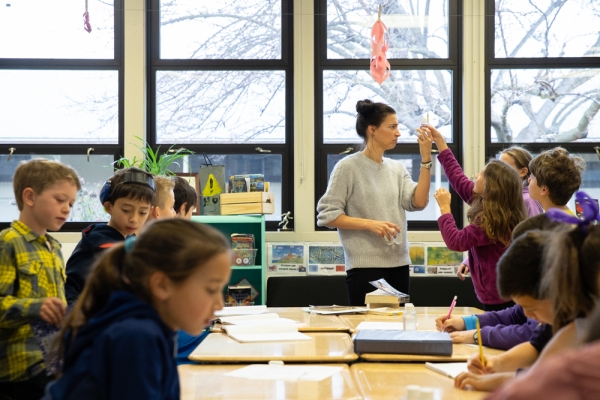Doors remain open between classrooms at Oak Knoll School in Menlo Park as kids -- a mix of third-, fourth- and fifth-graders -- watch their student-produced morning news broadcast.
This setup epitomizes the goal of the school's 11-year-old multi-age program in which three classrooms are connected, with three teachers and three classes of students who are in kindergarten through second-grade, or third- through fifth-grade. The innovative multi-age program is one of only a few on the Peninsula, and serves about 200 of Oak Knoll's 690 students. It aims to foster community and treat students as individuals rather than confine them to grade-level standards.
Students in this program start their day in multi-age community circles. They spend half the school day with their multi-age class and the other half day in a single-grade class. They remain in their multi-age homeroom for three years; teachers within the cohorts specialize in one grade level.
"When they're in the same class for three years, they are more comfortable and feel like it's home," said Principal Kristen Gracia, who came to Oak Knoll as a teacher nine years ago and became principal five years ago.
There is an emphasis on interacting with other students in the multi-age program. Multi-age classrooms integrate open-ended curriculum and project-based learning. Students take part in STEM (science, technology, engineering and math) projects, in-class science experiments, games and social events to meet other students.
Older students are encouraged to mentor younger students, and teachers and families come to know each other well over their three years together, school officials say.
Teachers recently launched Genius Hour, in which students choose something they want to study independently and are matched with an expert on that topic. Students then use technology to share what they learn.
Oak Knoll also has traditional one-teacher, one-grade-level classes, which administrators say give parents another option for their children.
How the program started
In 2008, David Ackerman, Oak Knoll's principal at the time, learned about multi-age schooling while attending the San Mateo County School Boards Association's Kent Awards ceremony, where John Gill Elementary School in Redwood City won an award for its multi-age program.
Ackerman visited John Gill to observe its program, and was impressed by the school's language arts-based multi-age learning community. He thought such a program could address challenges facing Oak Knoll: how to help struggling readers, how to increase teacher collaboration, and how to put more emphasis on relationships between students and teachers.
Soon after Ackerman's discovery of John Gill's multi-age program, Oak Knoll teachers put their own version of the program together. Teachers dedicated 20 days to research multi-age programs and one-room schoolhouses during the summer of 2008. They also wrote the social studies curriculum and modified the science curriculum. (The school teaches reading, writing and math by grade level.)
By fall 2008, Oak Knoll launched its own multi-age program, which started with a kindergarten, first- and second-grade group. A third-, fourth- and fifth-grade group would come a year later.
School administrators often commented that teacher-student relationships didn't reach beyond the nine-month-long school year in traditional classrooms, Ackerman said. Before multi-age classes existed, a new teacher had to learn about a new child and what motivated and interested that student each year, he said.
With the multi-age program, students "were off to the races right at the very beginning" of the school year since teachers had already established relationships with two-thirds of their homeroom, said Ackerman, who is now president of the Menlo Park City School District school board. Oak Knoll, where he retired from in 2015, is part of the school district.
"Students adapted to school much more quickly (with the multi-age program)," he said. "There was a sort of closeness and class camaraderie and support for each other when they stayed together for a couple of years."
Benefits: 'teaching empathy,' confidence and community
Research shows that the benefits of multi-age groupings for students go beyond the academic.
A 2006 study by Mary Ellin Logue, now a professor emerita at the University of Maine, found that early student disobedience was less prevalent in multi-age groupings than in single-age classrooms. Academically, because of higher rates of language exchange among children in these programs, students had higher language development, according to the study.
Renee Lavezzo, who specializes in the first-grade segment of a kindergarten, first- and second-grade group at Oak Knoll, is in her sixth year of teaching in the program. Lavezzo saw teaching multi-age classes as a chance to try something new, but challenging. She's seen firsthand how students benefit from mentoring one another, she said.
"There's a misconception that we're trying to make kindergartners grow up faster, but we're teaching empathy and compassion to show the younger kids the ropes," said Lavezzo, who will retire after 23 years of teaching at the end of the school year. "It's heartwarming to see how the older ones take care of the younger ones."
Sara Leslie, a parent of a fifth-grade boy at Oak Knoll, has had three of her children go through the school's upper-grades multi-age program. Her son has gained confidence as a leader to younger students in his cohort, she said.
"It's a really big school and the multi-age makes that really big school seem much smaller," she said.
Kianne, fifth-grader in the multi-age program, said she will miss her group when she goes to middle school.
"It's a very big, nice family," said Kianne, who is in Karen Clancy's third- through fifth-grade cohort. "Sometimes you get a family sensation when we're all together."
Students also tend to thrive in multi-age classes because they have three different teachers working with them for multiple years who can see their strengths and weaknesses, Ackerman said.
'Few and far between'
Although there is no data on how many multi-age classrooms there are nationwide, such programs are "few and far between," said Sandra Stone of the National Multi-age Institute at Northern Arizona University in Flagstaff, Arizona, and author of "Creating the Multiage Classroom." Stone founded the institute, which offers graduate-level courses in multi-age teaching practices.
The No Child Left Behind Act of 2001, which put an emphasis on standardized testing by grade level, made it difficult for multi-age programs to survive. Multi-age programs look at each child as an individual and don't use standards to measure them, Stone said. The programs are comfortable, yet challenging for students, Stone said. Curriculum is flexible so teachers can change the lesson plans based on what students are understanding.
Stone is concerned that traditional education doesn't support the wellbeing of students; she said that some schools might turn to nontraditional programs like the multi-age classroom to change this. Most traditional schools are creating factory-like conditions with paper-and-pencil tasks and workbooks, she said. Traditional education separates students into "winners" and "losers," which is unfair to children, causing them to lose their "wonder and excitement about learning," she said.
Gracia said students at Oak Knoll still prepare for standardized testing by grade level.
On the Peninsula, there are only a handful of multi-age programs, including ones in Hillsborough and San Carlos schools. The San Mateo County Office of Education doesn't track multi-age programs, Patricia Love, administrator of strategy and communication for that office, wrote in an email.
Challenges
It's important that teachers buy into and are prepared well to teach multi-age classes if a school wants to implement such a program, according to a 2009 research article from the Center for Evaluation and Education Policy at Indiana University Bloomington.
Many teachers have next to no preparation for teaching students of different ages, according to the article. About eight in 10 teachers oppose differentiated instruction -- a term for the adaptation of curriculum to meet all students' needs, according to the article.
Educators doubt their abilities to assign the groups, carry out the materials and efficiently create group work among students of different abilities and ages, according to a 2008 study by the Farkas Duffett Research Group. Teachers are also unhappy with the increased workload that comes with teaching multi-age classes, according to the Center for Evaluation and Education Policy article.
In establishing the program, Oak Knoll administrators had the most difficulty with finding teachers willing to take part in multi-age classes, Ackerman said.
"Teachers hate split classes (a class made up of two grade levels), so the idea of recruiting three teachers to run a multi-age program was difficult," he said.
The multi-age classroom is not the same as the split classroom, which consists of two or more consecutive grades being placed in the same classroom under one teacher who is tasked with ensuring that students receive instruction at their grade level, according to the blog A Multi-age Journey. Split grades are usually created for numbers of reasons -- too many students at one grade level, but not enough to make another full class of that grade, for example. The multi-age classroom functions as a single learning community.
Oak Knoll did get buy-in from three teachers willing to try multi-age classes.
"We sold them on the creativity idea," Ackerman said. "We sold them on the whole relationship idea and getting to know these kids for three years."
After the program's first year, the school made adjustments to aspects of the curriculum that didn't work. For example, administrators phased out a multi-age music program that wasn't working well, switching to the Suzuki Method violin program after the first year.
"It added to the mystique of the program," Ackerman said. "We had kindergartners running around with violins."
Clancy, who specializes in third-grade teaching, is in her 10th year of participating in the program. Teaching multi-age classes keeps her engaged as an educator, she said.
"I didn't know what I was doing at first," she said. "But we could make it whatever we wanted it to be and think outside of the box."
Clancy still tweaks curriculum as she goes, but said teachers in her cohort know what each grade level needs. Multi-age classroom teachers are more locked into a schedule and spend more time with students on a lesson than is allotted for them since students move on to other teachers during a school day.
The future of multi-age programs in district
There's been discussion about bringing multi-age programs to other schools in the Menlo Park City School District, but "it's not an easy thing to implement," Ackerman said.
"You have to really work and find the right teachers," he said. "It became easier at Oak Knoll once other teachers watched the first innovators do it."
Clancy said she'd be more than happy to help other teachers learn how to teach multi-age classes, but that she hasn't been approached about doing so.
For more on the program, go to here.
-









Comments
Registered user
Menlo Park: Suburban Park/Lorelei Manor/Flood Park Triangle
on Mar 3, 2019 at 10:44 am
Registered user
on Mar 3, 2019 at 10:44 am
We participated in this program for all 6 years at Oak Knoll and I can't say enough good things about the amazing teachers who took part. One benefit for us was the degree to which each teacher really KNEW our son. They had several years to observe him and figure out how he worked. And I believe that after breaking through his initial reserve (which can take a while!) they grew to genuinely care for him.
Of course, this means that the transition to middle school was more than a little jarring than it might otherwise have been–to go from a set of three teachers that knew you for three years to a set of six teachers who only see you an hour a day isn't easy. We'd make the same choice again in a heartbeat.
Registered user
Menlo Park: The Willows
on Mar 4, 2019 at 2:08 pm
Registered user
on Mar 4, 2019 at 2:08 pm
I was in a multi age classroom in 4th thru 6th grades at Escondido Elementary in Palo Alto in the 1970s. It was new at that point (there anyway). I wonder what happened to it? How long it lasted? Why it ended . . . (I assume it did).